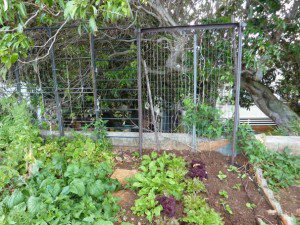
The trellises in the photo above are bed frames, railings, and other items collected from the side of the road. Other people’s trash is your free garden!
By Alina Niemi – Kitchen Garden International
Yes, the economy is in bad shape, I know. But don’t use that as an excuse for not gardening. You can take the expensive route and buy everything you need to get started, or you can be resourceful and end up with something that works, for little to no money. Here are some tips to get you started.
Contain It
The first thing you need is something to grow in. Start with the containers your food comes in. Asceptic boxes, plastic tubs, and plastic bottles, all of which you would otherwise just discard, can all be used as containers to start seeds in. Add some holes for drainage, some potting mix, and you’re ready to go.
You can also use newspaper pots. Strips of newspaper wrapped around a cylinder, with the bottoms folded under, aren’t sturdy enough for the long term, but they can be used to start seeds in. When you transplant them, put the whole thing, pot and all, into the ground or larger container.
[pro_ad_display_adzone id=”110028″]
Feed It
Fertilizer can be had in the form of compost, which is basically all your waste fruit and vegetable scraps, eggs shells, and some paper. Vermicomposting, or composting with worms, can even be done in a bin inside your house–tucked under your kitchen sink, for example.
You will reduce the amount of garbage that goes into landfills. You will get free fertilizer. You will give life to worms (if you vermicompost). And you won’t be forced to use chemical-filled soil mixes and fertilizers that are sold in garden and home centers, which may have a detrimental effect on our environment (not to mention your wallet).
Water It
The cheapest way to obtain water for your plants is to collect rainwater. You can use any container you like. (Avoid containers that have had toxic or cleaning chemicals in them.) I’d suggest covering them with screening to prevent mosquito infestation, especially if you’re in an area where mosquito-borne illnesses, such as encephalitis or Dengue Fever, can be a problem.
You can often find discarded 5-gallon buckets from restaurants. Be sure to clean them out thoroughly before you use them.
Reproduce It
Use what you buy from the grocery store to start more plants. Lemongrass and green onions are easy to grow and will provide you with leaves and stalks both. Lemongrass leaves make a delicious hot or iced tea. Use green onions in your salads and sandwiches.
Fresh herbs are commonly sold in grocery stores these days. Mint and sometimes basil can be started by placing a sprig in a jar of room-temperature water until roots sprout. Change the water daily and transplant as soon as possible, to prevent rotting.
Trade It
Become a part of an online gardening forum, a local gardening club, or something similar. Almost all of them have formal or informal seed swapping opportunities. Trade something you have a lot of, or seeds for something you’ve grown but don’t like, for something new. It’s also a great way to trade varieties that don’t do well in your climate, for something that didn’t work for someone else in theirs.
Train It
Use found objects as trellises for climbing or sprawling plants, such as pole beans, cucumbers, and tomatoes. The back of our little garden plot is lined with bed frames and rails, metal shelving supports, and other things. All of them were picked up from curbside, thrown out by others. Even if the metal rusts, it will last several years before it needs to be replaced.
So you see, you can be a cheapskate if you want or need to in your gardening efforts. But be sure to be generous with your harvest, and share it with your neighbors, friends, and others. I’ve fed arugula to electric company workers, herbs to neighbors, and cholesterol spinach to practically anyone who passes (since it grows almost without any help from me in our area.)
You’ll be opening their eyes to the pleasures of gardening, introducing them to new taste sensations, and maybe making them a little healthier in the process. And that way, they might not complain about the toilet tanks, truck tires, and bed frames in your yard that you are using to grow everything with!
I added a post to my blog if you want to see how to use toilet tanks as containers for your garden. They already come with drainage holes, they are rectangular, so you can stack them next to each other, saving space. And they are deep, so you can grow carrots and daikon in them, too. See using toilet tanks for container gardening
About the Author
Alina Niemi is a gardener, foodie, teacher, writer, illustrator, and traveler. She is the author of The New Scoop: Recipes for Dairy-Free, Vegan Ice Cream in Unusual Flavors
[pro_ad_display_adzone id=”110027″]






